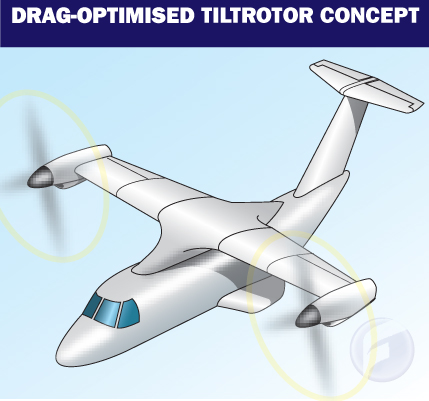With rotorcraft operations expected to increase sharply to try to meet ever-growing demand for medical, rescue and law enforcement missions as well as servicing busier city heliports, Europe is preparing to embark on its own massive technological sortie.
Part of the Clean Sky Joint Technology Initiative, a $1.6 billion public-private joint venture aimed at reducing the environmental impact of air transport, the rotorcraft integrated technology demonstrator (ITD) will see e160 million ($230 million) spent during the seven-year project to develop advanced rotorcraft technologies and validate them through to full-scale demonstrators.
The focus here will be on developing innovative rotor blades and novel turbine engine installations for noise reduction, together with diesel engine integration, airframe drag minimisation and advanced electrical systems for reducing fuel consumption.

Eurocopter will be teaming with AgustaWestland as leaders of the initiative, sharing 50% of the total activity with smaller businesses and research organisations such as DLR and ONERA contributing the remainder. Many of these participants are old acquaintances, having worked together through the European rotorcraft industries VERTAIR consortium which has co-ordinated past EC-funded collaborative research ventures.
Advanced diesel
One of the main projects will be the modification of an EC120 (2t class) light helicopter powered by an advanced diesel engine that will achieve a 30% reduction in specific fuel consumption, 40% reduction of carbon dioxide emissions and 53% cut in NOx emissions.
A second project will be to develop a future improved helicopter with turboshaft engine optimised for minimal power loss with reductions of 10% in specific fuel consumption, 26% reduction of carbon dioxide emissions and 65% reduction in NOx emissions.
Work is due to start in the middle of the year with the letting of initial contracts. It will build on the ongoing sixth framework EC Friendcopter project to integrate technologies in support of a passenger and environmentally friendly helicopter which launched in early 2004 and involves a consortium of 34 European partners.
Targets here are highly challenging, including a concerted effort to reduce the acoustic footprint areas up to 50% depending on the flight condition, reducing fuel burn up to 6% for high speed flights, reducing cabin noise levels below 75dBA, similar to airliner cabins, in normal cruise flight, and reducing cabin vibrations below 0.05g corresponding to smooth jet ride comfort for the same flight regime.
The Clean Sky rotorcraft initiative will also build on the work - albeit to a lesser degree - of OPTIMAL, part of the European research effort which addresses capacity of the air traffic system in an effort to better integrate helicopter operations. Another element that will provide a foundation for Clean Sky will be NICETRIP, which examined new rotorcraft configurations offering longer range and higher speeds.
Clean Sky efforts to reduce external noise include passive optimisation and active control techniques of rotor blades to minimise impulsive air loads and therefore the radiated noise, as well as the design of air intakes and exhaust nozzles to mask or absorb the noise of a turboshaft engine especially in hover and low speed flight conditions.
Cleaner and more efficient power use will also focus on design features of cabin volume, tail unit, rotor pylon and hub for the reduction of aerodynamic drag and download in cruise flight conditions, together with new electrical systems architecture enabling energy management optimisation.
In addition, the project will examine optimised flight procedures for tilt rotor configurations helping to reduce the noise footprint during approach and departure as well as the optimisation of low altitude navigation where noise impact minimisation will be achieved by 3D-optimised VFR and IFR routes relying on accurate GNSS satellite navigation (EGNOS, Galileo).
Lastly, Clean Sky will develop environment-friendly flight paths with optimised take off and landing procedures at helipads/airports located within densely populated areas as well as optimised mission profiles providing specific tools and methodologies to help lower fuel burn and NOx emissions.
The Clean Sky rotorcraft ITD will start determining which breakthrough technologies and advanced configuration demonstrator projects will go forward by mid 2010 with the ultimate selection scheduled for 2011. Year four will see the design, build and integration of these technologies on ground and in-flight demonstrations with year six and seven conducting flight test and validation of the technologies selected.
Source: Flight International
















